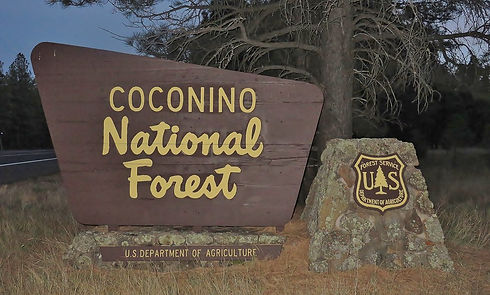Coconino National Forest

Planting in this forest.
The Coconino National Forest in northern Arizona has a rich history of restoration efforts aimed at rehabilitating ecosystems affected by wildfires and other natural disturbances. Among these, the 2024 Schultz Fire Replanting stands out as a significant endeavor.
In August 2024, the Coconino National Forest initiated a replanting project on the east side of the San Francisco Peaks, covering approximately 380 acres between Schultz Pass Road and Waterline Road. This area had previously been replanted following the 2010 Schultz Fire but suffered a total loss of 3,000 acres of young trees due to the 2022 Pipeline and Tunnel fires. Recognizing the importance of this region for watershed health and wildlife habitat, the project aimed to reforest areas that burned with high severity and were unlikely to regenerate naturally within a century. By planting new trees, the initiative sought to reduce soil erosion, improve wildlife habitat, and restore the timber base lost in recent fires. The replanting efforts were bolstered by the participation of over 200 volunteers, including community members and students, who contributed to planting thousands of ponderosa pine seedlings.
In 2022, the Radio Fire Recovery project on Mount Elden focused on rehabilitating areas affected by wildfires, with the planting of 2,000 trees to aid in ecosystem restoration. The same year, the Fort Valley Experimental Forest undertook a Wildfire and Tornado Recovery project, planting 41,000 trees to restore areas impacted by natural disturbances.
The years 2018 and 2019 saw significant community-based reforestation efforts in the Coconino National Forest. In 2018, approximately 51,000 ponderosa pine seedlings were planted across 300 acres as part of fire recovery efforts. This initiative engaged the Flagstaff community, Northern Arizona University students, and K-12 students, fostering a collaborative approach to forest restoration. The following year, in 2019, a similar project resulted in the planting of 50,000 trees, further contributing to the rehabilitation of fire-affected areas.
The Schultz Fire Replanting project of 2024 exemplifies the ongoing commitment to restoring the Coconino National Forest's ecosystems. These restoration projects play a crucial role in rehabilitating fire-affected landscapes, promoting biodiversity, and ensuring the health and resilience of forest ecosystems for future generations.
The restoration initiative at Coconino National Forest began as a response to decades of wildfire devastation, with the goal of planting hundreds of thousands of trees over several years. In 2024, volunteers played a pivotal role, achieving a remarkable success rate in seedling survival. By the fall of 2024, an additional 36,000 native conifer trees were planted, reaffirming the forest's importance as a thriving habitat and ecological treasure.




Location
Arizona, USA
Project Type
Reforestation
Environmental Benefits
Ecosystem Restoration.
Soil Stabilization.
Recreational Enhancement.
Climate Resilience.
Wildlife Support.
About this forest
Coconino National Forest, located in northern Arizona, is a diverse and breathtaking landscape encompassing lush pine forests, rugged canyons, towering red rock formations, and alpine tundra. Spanning over 1.8 million acres, it is home to iconic landmarks like the San Francisco Peaks and Sedona’s red rocks. This forest offers rich biodiversity and endless opportunities for outdoor exploration and adventure.




